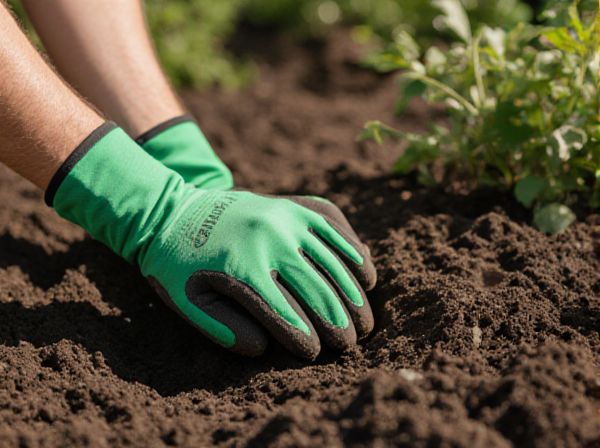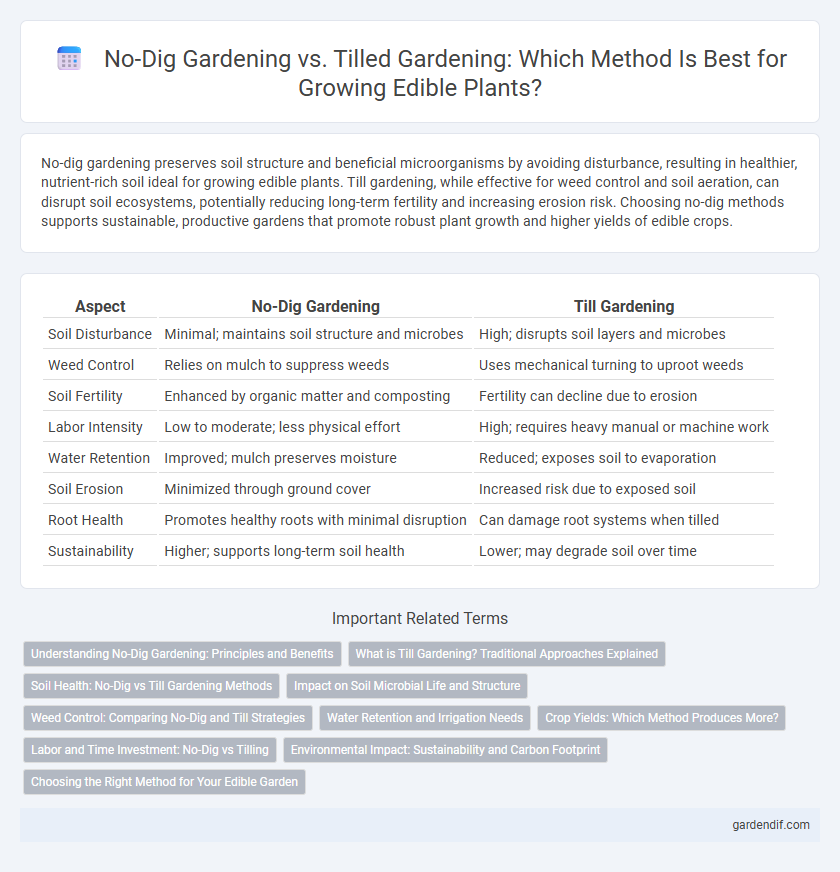
No-dig gardening vs Till gardening Illustration
No-dig gardening preserves soil structure and beneficial microorganisms by avoiding disturbance, resulting in healthier, nutrient-rich soil ideal for growing edible plants. Till gardening, while effective for weed control and soil aeration, can disrupt soil ecosystems, potentially reducing long-term fertility and increasing erosion risk. Choosing no-dig methods supports sustainable, productive gardens that promote robust plant growth and higher yields of edible crops.
Table of Comparison
| Aspect | No-Dig Gardening | Till Gardening |
|---|---|---|
| Soil Disturbance | Minimal; maintains soil structure and microbes | High; disrupts soil layers and microbes |
| Weed Control | Relies on mulch to suppress weeds | Uses mechanical turning to uproot weeds |
| Soil Fertility | Enhanced by organic matter and composting | Fertility can decline due to erosion |
| Labor Intensity | Low to moderate; less physical effort | High; requires heavy manual or machine work |
| Water Retention | Improved; mulch preserves moisture | Reduced; exposes soil to evaporation |
| Soil Erosion | Minimized through ground cover | Increased risk due to exposed soil |
| Root Health | Promotes healthy roots with minimal disruption | Can damage root systems when tilled |
| Sustainability | Higher; supports long-term soil health | Lower; may degrade soil over time |
Understanding No-Dig Gardening: Principles and Benefits
No-dig gardening preserves soil structure and microbial life by avoiding disturbance, promoting healthier plant growth and increased nutrient retention. This method reduces erosion and weed proliferation, encouraging natural decomposition and enhancing soil fertility. Emphasizing mulch layers and organic matter, no-dig gardening supports sustainable, low-maintenance edible garden production.
What is Till Gardening? Traditional Approaches Explained
Till gardening involves using tools or machines to break up and turn over the soil, promoting aeration and mixing organic material into the earth. This traditional method helps prepare the seedbed, control weeds, and incorporate nutrients, but can disrupt soil structure and beneficial organisms. Despite its drawbacks, till gardening remains a popular practice for installing new garden beds and enhancing soil fertility in conventional agriculture.
Soil Health: No-Dig vs Till Gardening Methods
No-dig gardening significantly improves soil health by preserving soil structure, maintaining beneficial microbial communities, and preventing erosion, unlike till gardening which disrupts soil layers and diminishes organic matter. This method increases nutrient retention and moisture levels, promoting robust plant growth without the need for synthetic inputs. Conversely, till gardening exposes soil to oxygen, accelerating organic matter decomposition and disrupting earthworm habitats essential for soil fertility.
Impact on Soil Microbial Life and Structure
No-dig gardening preserves soil microbial life by maintaining natural soil structure and minimizing disturbance to beneficial organisms like mycorrhizal fungi and earthworms. In contrast, till gardening disrupts soil aggregates and microbial habitats, leading to reduced microbial diversity and soil health degradation. Studies reveal no-dig gardens support higher microbial biomass and improved soil aeration, enhancing nutrient cycling and plant growth.
Weed Control: Comparing No-Dig and Till Strategies
No-dig gardening suppresses weeds by maintaining a thick organic mulch layer that blocks sunlight, preventing weed seed germination and preserving soil structure. Till gardening disrupts soil layers, which can bring dormant weed seeds to the surface, increasing weed growth and requiring more frequent weeding. Studies show no-dig methods reduce weed pressure over time, promoting healthier soil ecosystems and lower labor inputs for weed control.
Water Retention and Irrigation Needs
No-dig gardening significantly enhances soil structure by preserving organic matter, resulting in superior water retention compared to till gardening, which disrupts soil layers and accelerates moisture evaporation. This improved moisture retention reduces irrigation needs, making no-dig methods more water-efficient and sustainable for edible crops. Studies show no-dig beds can retain up to 30% more water, lowering overall water consumption in garden management.
Crop Yields: Which Method Produces More?
No-dig gardening often results in higher crop yields due to improved soil structure, moisture retention, and microbial activity that promote healthy root growth. Till gardening can disrupt soil ecosystems and lead to soil erosion, potentially reducing long-term productivity despite initial yield boosts. Studies show that no-dig methods enhance nutrient availability, supporting sustainable and increased crop output over time.
Labor and Time Investment: No-Dig vs Tilling
No-dig gardening significantly reduces labor and time investment by eliminating the need for physical soil turning, which can be strenuous and time-consuming in till gardening. This method allows gardeners to focus on surface mulching and planting directly, promoting faster bed establishment and less soil disruption. Tilling, while effective for initial soil preparation, demands repeated effort each season to break up compacted soil, increasing overall workload and time spent in the garden.
Environmental Impact: Sustainability and Carbon Footprint
No-dig gardening significantly reduces soil disturbance, preserving soil structure and microbial life, which enhances carbon sequestration and biodiversity compared to traditional till gardening. Till gardening increases soil erosion and releases stored carbon into the atmosphere, contributing to higher greenhouse gas emissions. Sustainable no-dig practices promote healthier ecosystems and lower the overall carbon footprint of food production.
Choosing the Right Method for Your Edible Garden
No-dig gardening conserves soil structure and microbial health by avoiding disturbance, promoting robust root growth and nutrient retention for edible plants. Till gardening, while effective for soil aeration and weed control, can disrupt beneficial organisms and lead to erosion, impacting long-term soil fertility. Assessing soil condition, crop type, and sustainability goals guides the choice between no-dig and till methods for optimizing yield and soil vitality in your edible garden.
No-dig gardening vs Till gardening Infographic

 gardendif.com
gardendif.com